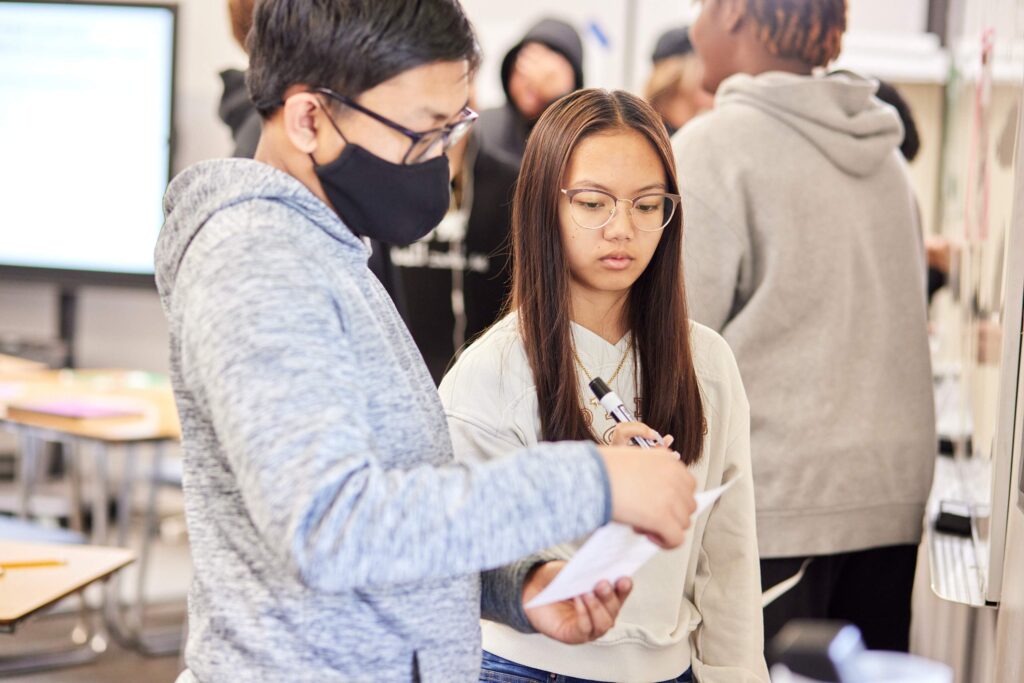May 2024

Intervention. Voice and choice. Ownership. Those were our goals when we started to think about how we wanted to do things differently in our classroom. Our classroom is an Integrated 1 co-taught classroom where one-third of the students have IEPs, 504s, and/or designations as English Language Learners. We were loving the conversations that we were hearing in our class, but the test scores didn’t match what we were hearing and seeing. We knew we had to do something different.
As we planned for our trimester, we decided to add in intervention days. We knew we wanted our students to have targeted interventions, but we also wanted them to have some voice and choice in what they wanted to learn. We created what we call “Throwback Thursdays” to do in-class interventions and allow our students to take ownership of what they felt they needed to work on. Activities range from Desmos, Quizizz, Blooket, worksheets, vertical surface work, and one-on-one intervention with a teacher. Each Thursday, we choose a concept that we feel our students need a little bit more instruction on and we work with each student individually to see where they are. This allows us to track some data to see their growth and to see where we can customize our lesson.
While we often think of interventions as something that should happen outside of the classroom, our students are involved in so many other activities that getting them to do more outside of class wasn’t an option. Creating “Throwback Thursdays” allowed us to focus on these important goals:
- Addressing Individual Needs: Every student has unique learning styles, strengths, and weaknesses. Targeted interventions allow us to identify and address specific areas where students may struggle, providing personalized support to help them overcome challenges and build confidence in their mathematical abilities.
- Bridging Learning Gaps: Without targeted interventions, learning gaps can easily develop, where some students fall behind while others progress. By pinpointing areas of difficulty early on and intervening promptly, we can prevent these gaps from widening, ensuring that all students build a solid foundation for future learning.
- Promoting Equity: Targeted interventions are crucial in promoting equity in the math classroom. By recognizing and responding to the diverse needs of students, we create a more inclusive learning environment where every learner has the opportunity to succeed, regardless of background or ability.
- Maximizing Instructional Impact: Rather than adopting a one-size-fits-all approach, targeted interventions allow us to allocate instructional resources more effectively. By focusing attention where it is most needed, we optimize the impact of our instruction, leading to greater student engagement, understanding, and achievement.
- Building Deep Understanding: Understanding of mathematical concepts requires more than just exposure to content: it demands ongoing practice, reinforcement, and support. Targeted interventions provide students with the additional time and resources they need to understand challenging concepts, helping them develop a deeper understanding of mathematics and build essential skills for future academic and professional success.
Targeted interventions in our math classroom are vital for promoting student learning, bridging gaps, fostering equity, maximizing instructional impact, developing deep understanding, and building relationships. By embracing these interventions, we create a more inclusive and effective learning environment where all students have the opportunity to thrive in mathematics.
[Editors Note: Mindy Karp and Lauren Hall both presented at the 2024 CPM Teacher Conference in their session “Throwback Thursdays.”]

Mindy Karp & Lauren Hall
Mindy Karp (Poway High School, Education Specialist. Poway, CA)
Lauren Hall (Poway High School, Mathematics Teacher. Poway, CA)

